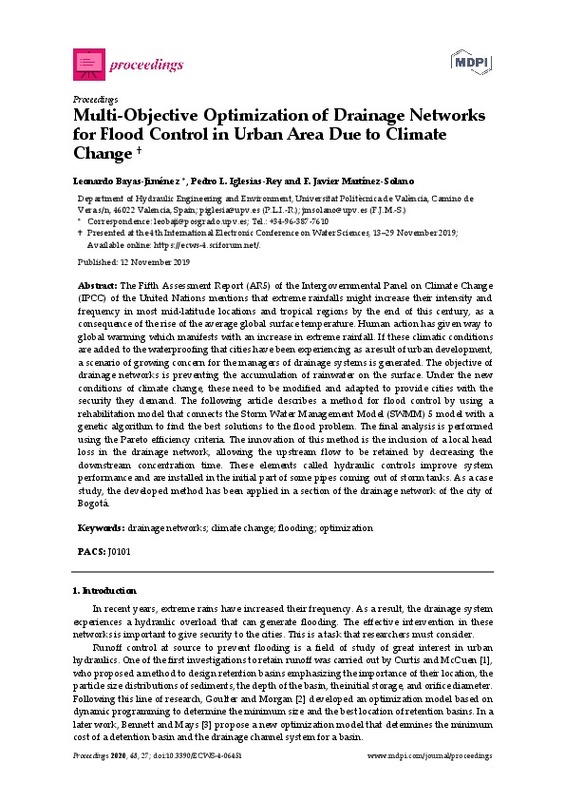JavaScript is disabled for your browser. Some features of this site may not work without it.
Buscar en RiuNet
Listar
Mi cuenta
Estadísticas
Ayuda RiuNet
Admin. UPV
Multi-Objective Optimization of Drainage Networks for Flood Control in Urban Area Due to Climate Change
Mostrar el registro sencillo del ítem
Ficheros en el ítem
| dc.contributor.author | Bayas-Jiménez, Leonardo
|
es_ES |
| dc.contributor.author | Iglesias Rey, Pedro Luís
|
es_ES |
| dc.contributor.author | Martínez-Solano, F. Javier
|
es_ES |
| dc.date.accessioned | 2021-09-16T03:32:02Z | |
| dc.date.available | 2021-09-16T03:32:02Z | |
| dc.date.issued | 2019-11-12 | es_ES |
| dc.identifier.uri | http://hdl.handle.net/10251/172600 | |
| dc.description.abstract | [EN] The Fifth Assessment Report (AR5) of the Intergovernmental Panel on Climate Change (IPCC) of the United Nations mentions that extreme rainfalls might increase their intensity and frequency in most mid-latitude locations and tropical regions by the end of this century, as a consequence of the rise of the average global surface temperature. Human action has given way to global warming which manifests with an increase in extreme rainfall. If these climatic conditions are added to the waterproofing that cities have been experiencing as a result of urban development, a scenario of growing concern for the managers of drainage systems is generated. The objective of drainage networks is preventing the accumulation of rainwater on the surface. Under the new conditions of climate change, these need to be modified and adapted to provide cities with the security they demand. The following article describes a method for flood control by using a rehabilitation model that connects the Storm Water Management Model (SWMM) 5 model with a genetic algorithm to find the best solutions to the flood problem. The final analysis is performed using the Pareto efficiency criteria. The innovation of this method is the inclusion of a local head loss in the drainage network, allowing the upstream flow to be retained by decreasing the downstream concentration time. These elements called hydraulic controls improve system performance and are installed in the initial part of some pipes coming out of storm tanks. As a case study, the developed method has been applied in a section of the drainage network of the city of Bogotá. | es_ES |
| dc.language | Inglés | es_ES |
| dc.publisher | MDPI AG | es_ES |
| dc.relation.ispartof | Proceedings | es_ES |
| dc.rights | Reconocimiento (by) | es_ES |
| dc.subject | Drainage networks | es_ES |
| dc.subject | Climate change | es_ES |
| dc.subject | Flooding | es_ES |
| dc.subject | Optimization | es_ES |
| dc.subject.classification | MECANICA DE FLUIDOS | es_ES |
| dc.title | Multi-Objective Optimization of Drainage Networks for Flood Control in Urban Area Due to Climate Change | es_ES |
| dc.type | Artículo | es_ES |
| dc.identifier.doi | 10.3390/ECWS-4-06451 | es_ES |
| dc.rights.accessRights | Abierto | es_ES |
| dc.contributor.affiliation | Universitat Politècnica de València. Departamento de Ingeniería Hidráulica y Medio Ambiente - Departament d'Enginyeria Hidràulica i Medi Ambient | es_ES |
| dc.description.bibliographicCitation | Bayas-Jiménez, L.; Iglesias Rey, PL.; Martínez-Solano, FJ. (2019). Multi-Objective Optimization of Drainage Networks for Flood Control in Urban Area Due to Climate Change. Proceedings. 48(1):1-9. https://doi.org/10.3390/ECWS-4-06451 | es_ES |
| dc.description.accrualMethod | S | es_ES |
| dc.relation.publisherversion | https://doi.org/10.3390/ECWS-4-06451 | es_ES |
| dc.description.upvformatpinicio | 1 | es_ES |
| dc.description.upvformatpfin | 9 | es_ES |
| dc.type.version | info:eu-repo/semantics/publishedVersion | es_ES |
| dc.description.volume | 48 | es_ES |
| dc.description.issue | 1 | es_ES |
| dc.identifier.eissn | 2504-3900 | es_ES |
| dc.relation.pasarela | S\424484 | es_ES |
| dc.subject.ods | 06.- Garantizar la disponibilidad y la gestión sostenible del agua y el saneamiento para todos | es_ES |
| dc.subject.ods | 09.- Desarrollar infraestructuras resilientes, promover la industrialización inclusiva y sostenible, y fomentar la innovación | es_ES |
| dc.subject.ods | 13.- Tomar medidas urgentes para combatir el cambio climático y sus efectos | es_ES |
| dc.subject.ods | 11.- Conseguir que las ciudades y los asentamientos humanos sean inclusivos, seguros, resilientes y sostenibles | es_ES |








